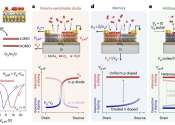Researchers create organic nanowire synaptic transistors that emulate the working principles of biological synapses
(Phys.org)—A team of researchers with the Pohang University of Science and Technology in Korea has created organic nanowire synaptic transistors that emulate the working principles of biological synapses. As they describe ...









